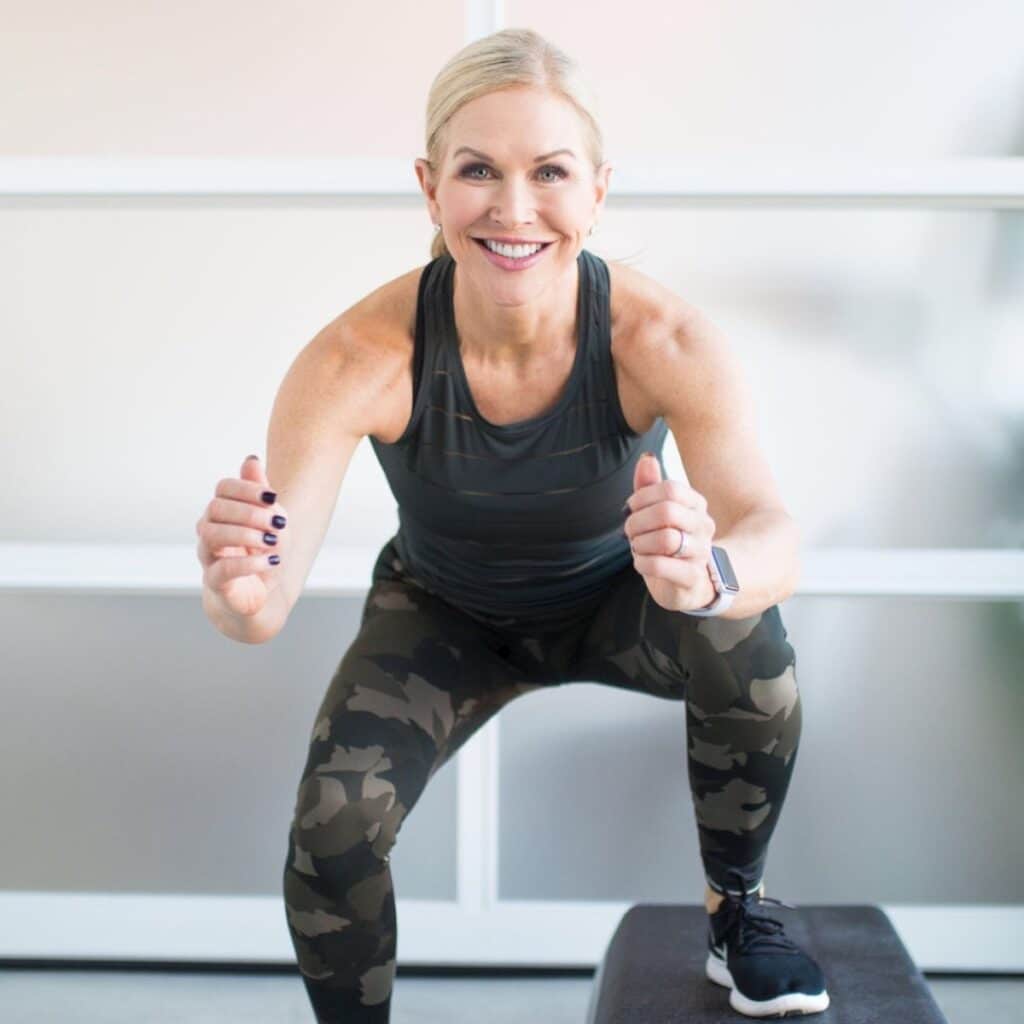This post contains affiliate links. Please see our disclosure policy.
You’re doing it: you’re exercising, getting fit and staying with it. Amazing! But now you’ve got some sore and tight muscles to boot. If you’ve been running frequently, you may be experiencing tight calf muscles. But the good news is that with these calf exercises at home designed for a gastroc and soleus muscle stretch, you can get back to full strength in no time.
Calf Muscles

Your calf is comprised of two main muscles: the soleus and the gastrocnemius. In addition, there is also a small muscle called the plantaris that runs between the two larger muscles.
The gastrocnemius makes up the bulk of your calf muscle and thus most people feel the most pain or tightness in this muscle.

Save This Article To Read Later
Why is my soleus so tight?
There are many reasons that you might experience tight calf muscles. Overuse from repetitive exercise, underuse from lack of movement, muscle strain or injury can all play a role. If you are experiencing sharp and intense pain, it’s a good idea to see a doctor and practice calf muscle stretches.
How do you stretch a soleus or gastroc?
As with any stretch, it’s best to start slow and only go to the point of tension, not pain. Breathe into your calf muscle stretches and hold each gently reaching deeper into the stretch as it feels right. The below calf stretches are designed specifically to target the soleus and gastroc muscles.
Calf Exercises At Home
When you’re experiencing calf tightness, a stretching routine is a must. It’s especially important before and after exercise as to not shock the already tight muscles. But whenever you feel tight muscles, it’s a good idea to stretch.
Try these seven calf exercises at home in order improve symptoms. Stretch before a workout to warm up the calf and get it ready for the work you are about to put in and after your workout to stretch and cool down the soleus!
Let’s get stretching!
1. Standing Wall Stretch
- Find a wall and start by standing a couple feet away from the wall.
- Place both hands on the wall in front of you and take a step forward with the right foot – you should have your right foot forward and your left foot slightly behind.
- With both hands on the wall, bend both knees and press the both heels into the floor.
- Hold for anywhere between 30 and 60 seconds.
- Continuing to bend and straighten the legs, keeping the heels on the ground will deepen the stretch through the back of the calves.
- Repeat the exercise 2 times and don’t forget to switch legs!
2. Down Dog Calf and Achilles Stretch
- Start in a downward facing dog position.
- Pressing your palms into the floor start with both legs straight and pressing heels to the floor.
- Keeping your left leg straight, bend the right knee and press the left heel toward the floor. The further down the heel, the deeper the stretch. Note that your heel may not touch the ground depending on your flexibility – don’t force the stretch!
- Switch sides and continue to hold the stretch for 5-10 seconds on each side.
3. Seated Calf Stretch with a Resistance Band
- Start seated on the floor, back up straight and legs stretched out long in front of you.
- Using a resistance band (with or without handles), wrap the resistance band/ rubber tubing around the arch of the foot to ensure security of the resistance band.
- Pull the band tight towards you so that there is tension on the band at all times. Moving your ankle from a flexed position, this should create a stretch through your calf, down to a pointed position (toes to the ground).
- Continue to pull the band tight and dorsiflex and point the toe for a total of 30 seconds. Repeat on the opposite side and repeat 2-4 times.
4. Lunging Calf Stretch
- Place your hands on your hips for stability and step one foot back into a mini lunge. In a lunge the front leg should be bent and back leg starts at a 90 degree angle.
- Driving through the front heel, drop the back heel down, aiming to press it flat to the ground. The more distance you have between the feet, the deeper the stretch through the soleus will be.
- Pressing the back heel down to the floor, hold for a couple seconds and release the soleus stretch by returning back to starting position.
- Repeat the bending and straightening of the back knee for 30 seconds. Complete on the opposite leg and repeat 2-4 times total.
5. Heel Drop Stretch
- Find a stair, bench or a slightly elevated surface.
- Step up onto the elevated surface and place both feet on the edge of the step.
- Inhale and rise to the balls of your feet, engaging the calves.
- Exhale and drop the heels down to the floor. Aiming to keep the legs straight at all times, dropping the heels down will deepen the stretch through the backs of the legs.
- Complete the back and forth motion of rising to the toes and dropping the heels for 30 seconds and repeat 2-3 times through.
6. Walking Bent Over Calf Stretch
This stretch is a great dynamic stretch for the entire back of the leg. Not only working on the calf stretch, but also deepens a stretch through the back of the hamstrings.
- Start in a standing position, hands by your side and feet about hip width distance apart.
- Take one step forward with the left foot.
- Digging the right heel into the ground, bending the left knee slightly and keeping the right leg straight.
- Flex the right heel back towards your face and lean over to grab onto the toes.
- Toes should be pointing straight towards the sky. Hold the stretch for anywhere between 2-3 seconds.
- Stand up and step forward with the opposite foot (right foot) and do the same thing on the left.
- You will repeat this pattern by walking forward and dorsi-flexing the toes to the sky for a deeper stretch through the calf and the hamstring.
*If you do not have enough room to do this stretch walking – you can do the exact same thing standing in place and not moving. Stand up in between legs, bend over and flex the toes back towards the face and hold for your 2 – 3 seconds.
7. Foam Roll Stretch
Using a foam roller, a technique also known as self-myofascial release, is also a great way to release tension in tight muscles. The foam roller is a great extra tool to use at the end of a workout to deepen the massage in the back side of the leg.
- Start in a seated position on the floor, extending the legs long in front of you.
- Position the roller under one calf at a time. Right above the ankle and below the knee.
- Using your hands behind you for support, lift your butt off the ground and slowly roll from below the knee down to the upper ankle.
- Slowly roll down the leg, feel free to pause at any sticky or sore spots.
- Experiment with the flexion of the toe – point the toe in (deepening the stretch on the inner calf) or toes pointed out (getting deeper into the outer edge of the soleus).
- Repeat for about 30 seconds on each side. Completing 2 rounds on each leg!
Should you stretch a strained soleus or gastroc muscle?
While stretching a tight soleus or gastroc can help relieve tension, should you stretch a strained muscle? A strained calf muscle usually occurs as a result of a sudden injury rather than tightness over time.
While stretching can and should be a part of your rehabilitation, if the strain is new, be sure to practice “RICE:” rest, ice, compression, elevation. Take it a bit easier with some low impact activities such as walking for exercise as to not aggravate your symptoms further. Then practice the above calf exercises at home , gently, in order to get yourself back to normal.


